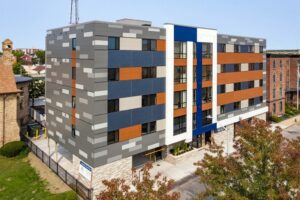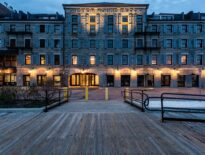
XLVII West Elm, Brockton’s first ground-up, all-market-rate development in many years, was fully leased a little over one month after opening in September. Photo courtesy of South Shore Property Management
Brockton’s multifamily-fueled revival is holding steady even as many parts of Greater Boston’s commercial real estate world have been buffeted by COVID-19. Local officials and developers are certain the city’s mix of lower land prices and close transit connection to downtown Boston will continue to accelerate growth downtown.
Not five years into a 20-year downtown revitalization plan that hoped to grow 1,000 units of housing in the neighborhood, around 800 units of housing have already been completed or are slated to come online in the next two to three years, said Brockton Redevelopment Authority Executive Director Robert Jenkins.
“It’s sort of mind-boggling when you think about it,” he said.
And the fall delivered a slate of good news for the city, too, that has opened the door for more.
XLVII West Elm, the city’s first all-market-rate, ground-up luxury development in recent memory completed lease-up in little over one month, despite opening on Sept. 1 as rental landlords in Boston’s core struggled to secure tenants amid a market disrupted by COVID-19.
One of downtown Brockton’s most prominent buildings, known locally as “the Furniture Building,” emerged from a long-running ownership dispute on Nov. 11, clearing the way for the 8-story building’s conversion into 44 market-rate and 11 affordable apartments. Construction expected to begin soon.
City officials say Trinity Financial will also likely begin construction early next year on the 102-unit second phase of its 215-unit, mixed-income Enterprise Block project that served as a proof of concept for downtown multifamily investments.
And in a sign transit-oriented development is poised to spread beyond downtown, state officials announced a pair of grants in October and November that will put over $3 million into infrastructure upgrades and business relocation assistance to help the owner of a truck repair business unlock his 1.26-acre lot for redevelopment into a 94-unit apartment building next to another of Brockton’s three commuter rail stations.
City Layers Incentives
Brockton’s recent flurry of multifamily construction is founded on what city officials call a “seven-layer dip” of incentive programs, including a 40R smart growth district written into city zoning, a federal Opportunity Zone and the state’s Housing Development Incentive Program (HDIP), a flexible tax credit equal to up to 25 percent of development expenses.
“They’re absolutely essential to make Brockton attractive to projects like this,” said Metro South Chamber of Commerce President and CEO Chris Cooney. “Everything from HDIP to Opportunity Zones to incentives to preserve historic windows in your mill building.”
In the case of the 5-story, 44-unit XLVII West Elm, receiving HDIP tax credits made the project feasible, said South Shore Property Management Principal Geoffrey Anatole, the project’s developer.
The building replaced a vacant, fire-damaged building after the Brockton Redevelopment Authority acquired the property, demolished the old structure and sold the land to Anatole’s firm.
“Having the city work with you makes a lot of things easier,” Anatole said. “Everyone wanted this to happen.”
The building has attracted a mix of Brockton residents and tenants from outside the city with monthly rents between $1,575 and $1,750 for a one-bedroom unit and $1,800 to $2,200 for a two-bedroom unit. But the Gateway City’s lower land prices – and construction savings thanks to being able to keep the project’s contracting work in-house – left room in the budget to outfit the building with contemporary luxury finishes like waterfall countertops and heavy soundproofing between units, plus gated and covered parking.
TOD Proves Resilient
The project’s location a nine-minute walk from the Brockton MBTA commuter rail station was key to attracting tenants, Anatole added.
“You can be 30 minutes from Boston in Brockton and pay 30 percent of the rent,” he said.
However, the MBTA’s board is set to vote Dec. 14 on $140 million in service cuts to help cover the loss of fare revenue due to COVID-19, which could include a significant drop in the number and frequency of commuter rail trains. MBTA officials promise the cuts are temporary and will be restored once demand returns, but activists and many local officials are skeptical.
Cooney and the Redevelopment Authority’s Jenkins both said they are confident Brockton will still be attractive to developers and multifamily tenants alike.
“I think the cuts are temporary and as soon as the stimulus and vaccine arrive in a couple months, there are going to be more trains, more business,” Cooney said.
During COVID-19 the city and the rest of the south metro have dodged the softness that hit multifamily landlords closer to downtown Boston, said Newmark Research Director Liz Berthelette.
“There are a lot of people who live down there because of the strong commuter rail infrastructure,” she said. “The region is very interconnected. If people continue to go into downtown and work even on a part-time basis there will be continued demand for multifamily property on or near transit.”
Future on the Horizon
Even as its multifamily boom continues to draw developers, lenders and tenants, Brockton’s stakeholders are starting to look to the city’s next phase.
With a solid base of potential customers growing downtown, the Redevelopment Authority has stood up a $1.5 million small business loan program to help local small and home-based businesses fit out new restaurants in the neighborhood.
And a coalition of five lenders – Brockton-based HarborOne Bank, Eastern Bank, Rockland Trust Bank, Crescent Credit Union and North Easton Savings – have come together to seed a second $1 million low-interest loan fund aimed at helping grow and advise homegrown small businesses.
“I expect there will be a strong push to grow small businesses downtown” in the wake of COVID-19, HarborOne Chief Lending Officer Scott Sanborn said.

James Sanna
The city is also close to adopting a second, 20-year urban renewal plan for a collection of polluted light industrial properties and a vacant 30-acre former rail yard next to downtown. The plan calls for the city and the Redevelopment Authority to midwife the creation of another 200 to 300 housing units, ground-floor retail and around 185,000 square feet of flex industrial or office space on the site, also tied to the nearby commuter rail station.
In a year that’s seen strong growth in the industrial sector across Greater Boston, the southern side of the metro area alone has already seen 1.5 million square feet of positive absorption so far this year, according to Newmark research, with the asking rent for flex space hitting $13.21 per square foot in the third quarter. While the south metro has historically been one of the region’s largest industrial real estate submarkets, Newmark’s Berthelette said, demand is being driven by a wide range of sectors across Greater Boston. Amazon and brick-and-mortar retailers are looking for distribution facilities to fuel e-commerce operations, some manufacturing firms are onshoring some operations and even biotech firms are turning to the suburbs to add production capacity.
“We’re in the midst of one of the strongest industrial markets we’ve ever seen,” Berthelette said. “We don’t really foresee tons of headwinds for that asset type.”
In this context, efforts like Brockton’s Trout Brook plan will be key to its long-term financial and economic health and for the health of other Gateway Cities, said Tracy Corley, the transit-oriented development fellow at MassINC.
“We don’t just want housing developed in Gateway Cities because cities are responsible for infrastructure. They need to have a mix of uses – commercial, industrial, educational, health care, housing,” she said. “In Boston, 39 percent of property tax revenue comes from residential sources. In Gateway Cities, it’s more like 71 percent.”




 |
| 

